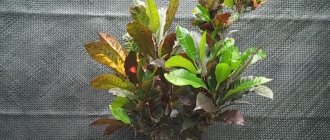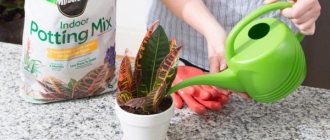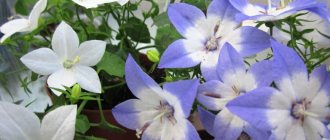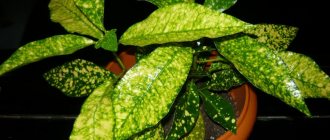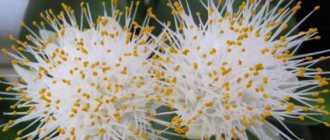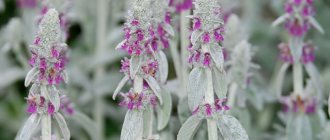Croton is an interesting ornamental plant. Its other name is codiaeum. Many gardeners use both, considering them synonymous, although these are two closely related genera belonging to the same family. The plant has another popular name: Joseph's cloak. It refers to the biblical story of Joseph the Beautiful (son of Jacob).
Photos of varieties of codiaum can be seen in the article at the link, where the most popular and attractive varieties are selected.
Briefly about care
- Watering. Abundant, warm, settled or filtered water. Between waterings, allow the top layer of soil to dry a couple of centimeters deep.
- Lighting. Loves bright diffused light. It is useful to expose the flower to morning or evening sunlight.
- Humidity. Maintain at 70–80%. Place a humidifier or container of water nearby. The plant needs to be sprayed every day.
- Temperature. The tree develops well at 20 ᵒC–26 ᵒC. During rest, you can reduce it to 18 ᵒC. Croton codium begins to react sharply to temperatures below 17 ᵒC.
- Blooms. It produces inflorescences in adulthood. Flowers greatly weaken the plant and do not serve a decorative function, so they are removed.
- Rest period. From November to February the bush slows down its development; at this time it is permissible to slightly reduce the ambient temperature.
- Transfer. They simply do transshipment for young plants a couple of times a year, for adults once every 2-3 years. For trees older than 5–6 years, the soil on top is simply changed.
- The soil. Croton needs porous and nutritious soil. For looseness, add sand, coal, vermiculite or a small amount of sphagnum moss to the soil.
- Fertilizers. From March to October it is necessary to feed 2 times a month with a high-potassium fertilizer. In winter, once a month, or give the roots a rest during this period. Be sure to fertilize on watered soil.
- Reproduction. The shrub is grown from aerial shoots, seeds and two types of cuttings. The most popular and simplest is growing apical cuttings.
- Diseases. Mostly fungal. The manifestation of diseases is provoked by improper home care.
- Pests. They appear rarely and only on weakened plants. Like diseases, they are the result of inappropriate care.
Signs and superstitions
Traditional healers believe that codiaum has high energy:
- helps you move up the career ladder;
- protects against the evil eye;
- helps accumulate positive emotions;
- increases performance;
- helps develop creativity;
- promotes order in all respects.
Recommended for indecisive people, pessimists, those who do not believe in themselves.
Description of the plant
Croton (codiaum) is a very beautiful indoor plant; it is often used to decorate various interiors. The appearance is similar to a tree or an upright bush.
In native tropical forests it grows to a height of three meters. Cultivated forms reach a maximum of 1.5 meters, often stopping at one. Some varieties have dwarf sizes up to 60 cm high.
The leaf is dense, leathery, in different shades of traffic light colors: red, yellow and green, with a slight glossy sheen and clearly visible veins. Some varieties have very dark foliage, even black.
The color and shape of the spots depends on the age of the plant and lighting.
With proper care and location, young light-colored yellow-green leaves develop patterns and gain color over time. The plates themselves vary: from an elongated narrow-leaved form to a three-fingered one; from straight cut to intricately curved sheet.
Croton's stem is straight and thin compared to its massive foliage. Often the trunk needs strong support so that the plant does not break. Usually the bush branches well, but the side shoots grow slower than the central one. Only some varieties have difficulty sprouting new branches.
The crown forms slowly. For a beautiful and lush appearance, the plant needs to be periodically given a kind of “haircut”. They begin to form a crown at one and a half years old.
The Croton tree belongs to the Euphorbiaceae family and has toxic sap. It can cause diarrhea or vomiting. In case of contact with skin, it can cause both irritation and burns.
The milky sap of croton is poisonous to both animals and humans. It is better to keep Croton out of the reach of children and animals. And when working with the plant, it is advisable to wear gloves and long sleeves. When finished, wash your hands with soap and thoroughly clean all tools.
Changing location is stressful for a picky flower, which is why it is so important to purchase a healthy plant. When purchasing, pay attention to the leaves. They should be bright, elastic, without spots or dry areas. On a healthy tree, the foliage at the top faces upward, and below it is located almost horizontally. The trunk should not have holes - this is the result of falling leaves. Pay attention to the soil: the lump should not be overwatered or dried out.
When buying a moping plant and changing its location, there is a risk of aggravating croton disease, up to the loss of all its decorative properties or the death of the flower.
There are several signs and superstitions associated with croton, and it is not for nothing that it is called the guardian of the home. He is able to cleanse the house of negative energy, and prevents people with bad thoughts and energy vampires from approaching. The flower supports the owners in all endeavors and has a positive effect on emotions. It also helps to cope with diseases of the kidneys, adrenal glands and bladder, and smoothes speech defects. A bad omen is a flowering plant: a kind of warning of danger. It doesn’t have to be serious, but it’s worth paying more attention to business and the surrounding situation.
Characteristics of the codium variety and species diversity
Codiaum is a shrubby, herbaceous or woody perennial plant. At home, the flower grows up to 1.5 m. The decorative value of the plant is its leaves. Depending on the type, the leaf blade may have the shape of an oval or blade.
All codiaums have elastic and succulent leaves. The surface of the plates is smooth, glossy, with pronounced veins. The color of the leaves is varied, represented by a combination of several colors. Many species have leaves with wavy, often curled edges.
Main types of flower:
- Codium Variegated is the species from which all other hybrids used in indoor floriculture originate. Representatives of this species are distinguished by variegated leaves. The outer side of the plate is painted dark green. It has bright yellow veins. The underside of the leaf may be green or dark red with honey-colored veins.
- Codium Petra is characterized by dark green oval leaves with light yellow wide veins. With age, the reverse side of the plate takes on a reddish tint. A border of the same color appears on the outer part of the leaf.
- Codium Excelent has lobe-shaped leaves, their color depends on the age of the plate. Young ones are light green in color with prominent lemon veins. The old ones have a double color: an olive-toned outer side with honey veins and a burgundy inner side with prominent light veins.
- Codiaum Mammi is an indescribably beautiful flower with spiral-shaped leaves. Fresh leaves have a bright green color. Over time, the plate changes its color to scarlet. The oldest leaves are dark burgundy in color.
- Codium Sunny Star has elongated leaves of unusual color, which is expressed by a sharp transition of lemon and juicy green shades. Some plates have equal amounts of green and yellow, some have only specks or veins of a certain color.
Codeum Sunny Star - Codium Mix has an indescribable color palette. The medium-sized oval leaves are painted in the most unimaginable colors. Among them there are combinations of lemon and bright green, pale lilac and burgundy, light green and dark green, olive brown and pale pink.
- Codium Gold Sun has oval leaves. The outer side of the plates is painted a rich shade of green. Yellow specks are thickly applied over the entire surface. On the reverse side the color is paler.
Codeium Gold Sun - Codium Tamara is represented by elongated leaves with a corrugated edge. The color of the plates is a sharp transition of white and dark green shades. Looking at the flower, it seems as if milk was spilled on it.
Codiaum Tamara
Croton bloom
Croton is a decorative deciduous species, but it also belongs to flowering plants. It blooms rarely, already in adulthood and with proper care of the bush. The raceme inflorescence emerges from the leaf axil (the connection between the petiole and the stem), the arrow contains up to two dozen small yellow-white flowers.
Croton bloom
Flowers can be either male or female. But there is only one view on one arrow. Male ones are round balls studded with stamens, and female ones are curved pistils. During flowering, the plant produces two arrows with different sexes.
Croton flowering is not as spectacular as its leaves, but it takes a lot of nutrients. Flowering also greatly reduces the development of the plant for 3–4 months. Therefore, many gardeners, when an arrow appears, immediately remove it.
Main types
Codiaum Variegated (variegated)
The flower got its name due to the color of the leaves, about 30 centimeters long, spread evenly along the trunk of the plant, and decorated with bright green and red veins. For clarity, after the description of each species, a photo of a flower is presented.
Codiaum Mammi
This species is distinguished by its narrow elongated leaves, slightly twisted in a spiral. Their color is bright red, burgundy, with green, yellow and brown streaks.
Disraeli Codiaeum
The Codiaum plant is distinguished by the beauty of the color of its thick, fleshy leaves. Its top is bright green, and below the color scheme smoothly turns into red shades. The shape of the leaves themselves is standard - oblong, with a rounded end.
Codium Mix
This variety has small variegated pointed leaves, no more than 20 centimeters long (in rare cases, the leaves are more expanded and grow up to 30 cm). Their color is varied and includes green, yellow, pink, red, and brown shades, often present simultaneously on the same plant.
Codiaum Tamara
This variety was bred in England and dedicated to the beautiful girl with whom the emperor was in love. The leaves of this plant are elongated and wavy at the edges, pointed at the end. They are distinguished by a unique white color with green splashes and veins. In rare cases, pink and yellow shades are also found in this variety. Tamara blooms only in wild conditions.
Environment
Proper home care of croton is based on “three pillars”: high humidity, optimal temperature and necessary lighting. If the optimal parameters of these categories are observed, croton is almost not capricious.
Humidity
Croton prefers high humidity (70–80%) environments. Codiaum feels good if there is a humidifier or just an open container of water nearby. You can also use a double pot with a layer of wet peat or moss; pour pebbles or moss into the tray, moistening them periodically.
Croton requires daily spraying and weekly leaf wipes. If this is not done, then there is a risk of spider mites infesting the croton. The tree will be grateful for a periodic shower or bath.
The frequency of basic water procedures is determined by the plant, but showers are stopped during the dormant period. Reduce the intensity of watering: the lump should be slightly damp.
The number of spraying and wiping should be reduced during the heating season, if there are no radiators nearby. Otherwise, the plant needs to maintain high humidity and regulate watering.
Temperature
Comfortable temperature for a flower: 20 ᵒC–26 ᵒC. If it is higher, it should be moistened more often. Croton responds well to fresh air: in warm weather it is placed on a loggia or balcony.
Croton has a negative attitude towards drafts and significant temperature changes. In winter, it should not touch a cold window, and watering should only be done with water at room temperature.
The dormant period is expressed by slowing down and stopping the development of the bush, and takes place in the winter season, from November to February. The optimal temperature for this period is 18 ᵒC, and below 17 ᵒC is already dangerous for the plant, it freezes.
General information
The codiaum flower feels good when grown indoors. This plant has many varieties , each of which has its own leaf color. Codiaum Mix looks especially beautiful on the windowsill. The shades of the leaves of different varieties are different; the leaf blades of crops can be yellow, dark purple and even red . Pink spots are clearly visible on individual leaves.
It is quite difficult to obtain inflorescences from a crop when caring for it at home. If all growing conditions are met, codiaum blooms in the warm season, in summer.
Note! The inflorescences of the plant are small, almost invisible against the general background of foliage. Gardeners purchase this crop solely for the sake of its beautiful decorative leaves.
Watering and wet care
Water for home care is used to use settled or filtered water. It should be warm, slightly warmed up.
During the period of active growth (spring and summer), the plant is watered abundantly. To avoid waterlogging, wait until the top layer dries a couple of centimeters between waterings. In autumn, the frequency of watering is reduced, and in winter the soil is left dry for several days. During this period, the rule applies: the lower the temperature, the less watering.
At any time, the soil should not be allowed to dry out completely: the leaves of the croton droop. If this happens, water the lump well (you can put it in water along with the pot) and spray the leaves. The ground will absorb the required amount of water, and excess water will drain away.
You need to spray the bush at least once a day, twice during dry periods. The above-ground part is bathed in the shower once a month. Croton loves cleanliness: when dust accumulates on the leaves, the plant gets sick. Dirt interferes with air exchange and slows down the process of photosynthesis, and also contributes to the appearance and activity of harmful insects. Therefore, the codiaum must be carefully wiped with a damp cloth once a week.
The more often you spray croton, the fewer problems there are with it.
How to save a croton that has dropped all its leaves
A bush that has completely shed its leaves but retained its stem must be resuscitated. To restore the plant’s strength, you will need to prepare an Epin solution and generously spray the bush with it. Next, place the pot with the culture in a bag and put it in a dark place for 12 hours. After half a day, it is necessary to remove the package and install it in the most illuminated place, but without direct rays of the sun hitting the crown.
Watering is scanty, only after the top lump of earth has dried out. Due to the fact that there is no foliage, there is a possibility of the soil becoming waterlogged, so you need to be careful with watering. After 2 weeks, new foliage should appear from the swollen buds.
For your information!
If all the leaves of a plant have fallen off and the trunk begins to dry out, resuscitation will not help, the croton will die anyway.
Trimming
Before the active growth phase, croton is pruned. With a sharp knife, in one motion for each stem. Each cut is treated with charcoal, several times if necessary. After the procedure, the plant is given time to get used to the new crown, moving it to partial shade and reducing watering.
Croton should not be sprayed immediately after pruning! The cut areas may begin to rot.
The procedure is carried out for two purposes: to form a crown or stimulate growth.
Creating a beautiful crown shape
- It is carried out more often in young plants. Some gardeners ask how to prune croton so that it is fluffy. To form a lush crown in the croton, shoots are periodically pinched, forcing the bush to branch. The first procedure is carried out at approximately one and a half years, when the stem reaches a height of 15 cm. This is done to stimulate the growth of side shoots, since they grow slower than the main stem. After six months, the growth of young shoots is adjusted. Subsequent “pinching” occurs as the stems grow to 20 cm, and this is repeated for all shoots.
Stimulating development in adult shrubs
- Ficus croton needs full pruning at the age of 5 years. At this time, the bush slows down its growth processes, and this procedure is carried out to stimulate its development.
- Haircut or pruning for hygienic purposes: remove dried and diseased stems and leaves. Carry out for plants older than 2–3 years.
Before the shearing or pruning procedure, be sure to remove inflorescences or flower buds so that the plant can safely survive the procedure. Also, do not touch the plant during illness, it may die.
Varieties
Motley
Genuine has elongated, rounded leaves, tapering towards the ends. The center of the upper side of the sheet is decorated with a thin gold-silver pattern. The leaves are also reddish.
Oval-leaved
In accordance with the name, it grows leaf blades rounded at the ends with bright golden-yellow spots along the top of the leaf and near the veins.
Decorated
Painted with bright yellow and red spots on a green background of elongated, pointed leaves.
Lapel-leaved
This variety has wide, rounded leaves that are turned outward at the edges.
Tortoiseshell
The base of the leaf is widened, it lengthens towards the end, and has a weakly expressed spirality. The general background of the leaves is green with an olive tint, the central vein is red, with a longitudinal golden-yellow stripe, and then golden spots are scattered. Completely yellow, orange or red leaves can grow on the same specimen at the same time.
Three-blade
Decorated with foliage with carved edges, vaguely similar to oak. This variety is characterized by golden veins, stripes and spots.
Wrapped
Indeed, it turns its wide leaves, pointed at the ends, inward, towards the stem, so that the plant becomes spherical.
Forms
Narrow-leaved - leaves are centimeter wide, somewhat elongated towards the top, have a length of 15-20 cm; golden spots are scattered across their greenery.
Appendage-like - the initially wide leaves narrow, becoming, as it were, a second petiole for another smaller leaf. The shape of this formation resembles a guitar. Such codiaums come in both variegated and green.
Curly cultivar Spirale – leaves are long, narrow, spirally wrapped. They, on a green background, are decorated with spots, stripes, and mesh patterns of warm yellow color.
Lobed - with wide, large leaves that have three distinct parts: the central one is much larger than the two lateral ones, separated by a noticeable notch. Yellow spots and splashes are scattered on a green background.
Such types of Codiaum as: Tamara, Excelent, Petra are also very popular in home cultivation.
Transplanting a plant
In order not to expose the bush to unnecessary stress, a simple transshipment is usually done in the spring. A lump of earth is touched only in cases of soil acidification, the presence of pests or root rot. To maintain the integrity of the mass, the plant can be watered well before the procedure.
Young bushes up to two years old fall over as they grow, usually once or twice a year. Adults - once every 2-3 years. When plant growth slows down, only the top layer (5–6 cm) of soil is changed. A decrease in development activity occurs closer to 5–6 years, when the diameter of the pot reaches 23–25 cm.
The codiaum plant loves transshipment and will thank you for it with a lush crown. The shrub urgently needs replanting when the roots come out of the water drainage holes.
After purchase, you should not immediately replant the croton; within two weeks it should get used to the new environmental conditions. If this is not done, the plant will get sick. After quarantine-adaptation they act as during normal transshipment. There is no need to change the soil if there are no diseases or pests, you just need to add fresh soil.
When transplanting, observe the following conditions:
- The pot for croton is larger than the diameter of the roots or the previous container by 2–4 cm. It is of medium depth, but the roots must not reach the drainage. The main rule when choosing a pot is that there should not be a lot of free space, otherwise the roots will begin to rot. Young plants can be planted in a plastic container; it will help track the condition of the roots. And for an adult bush, ceramic is preferable: it will serve as a kind of counterweight for heavy roots and absorb salts unnecessary for codiaum.
You need a pot with good drainage holes. Croton loves moisture, but excess water is detrimental to the root system.
- The soil for croton needs to be light, slightly loose and fertile, with the necessary microelements. You can take a ready-made substrate for palm trees or ficus trees, or prepare it yourself. There are many recipes for such compositions. Usually garden soil, peat and sand are mixed in equal proportions. Another simple way: mix universal soil with orchid soil and charcoal. To increase fertile properties, add compost, humus or leaf soil to the mixture. For more airiness, you can use chopped sphagnum moss. For drainage, take expanded clay, small broken bricks or polystyrene foam.
When working with sphagnum moss, it is worth considering that it remains wet for a long time, so it is added to the soil for croton in small quantities and only chopped.
Before use, the pot and soil are disinfected: spilled with boiling water or a solution of potassium permanganate.
Problems with improper cultivation
If the conditions in which the flower lives are comfortable are violated, certain difficulties may arise:
- exposing Codium to direct sunlight can burn its leaves, causing it to start to hurt;
- if you choose the wrong location for the flower, where there is not enough light, it will begin to stretch in length and fade, losing the brightness of its tropical color;
- lack of moisture will cause the leaves to dry out;
- low air humidity can lead to leaf fall and the appearance of harmful insects;
- accumulation of dust on the crown can cause plant diseases;
- low temperatures cause Codiaum leaves to fall off.
Reproduction
Reviews about the flower are diametrically opposed: some write that it is almost impossible to propagate, while others say that croton grew easily and simply. So what is the reason for such different opinions? It's all about choosing the right method and time for reproduction.
Like most plants, there are several ways to propagate croton at home. These are cuttings, layering and seeds. The first two are used from April to June, when the plant has just emerged from the dormant phase and is actively beginning to develop. Seeds are planted in January–February.
Air layering
This propagation of codiaum is more often used due to a disease: when the stem is exposed. Or in adulthood, when there are a lot of woody shoots. In both cases, propagation using air layering is used in two ways.
- The first method is good if the plant has lost its decorative function. Choose a place on the stem at a distance of 10–15 cm from the top, and if necessary, clear it of leaves. The bark in this area is removed in a circular manner. The width of the exposed part should not exceed 1 cm. The cut is treated with a growth stimulator, wrapped in sphagnum moss or peat, and covered with film to maintain moisture. For convenience, you can use a plastic cup instead of film. The roots will appear after a month, but the cuttings are separated when they grow to 5 cm. Small roots are not able to feed large croton leaves well. There is no need to worry about how to root croton: in suitable soil the shoot will take root well. The pot is moved to a shaded place for several weeks. Care and watering as for an adult plant.
- The second method is more suitable for an adult plant, when the stems are mostly woody. The shoot is bent to the ground (you can use a pot or bucket with soil). The bark is also removed from the area closest to the soil and the cut is treated with a growth stimulant. The selected area is secured with wire and moist soil is poured on top. Within a month, leaves will appear from the ground. After they grow up, the cuttings are dug up and transplanted into prepared soil. The pot with the young bush is placed in a bright, shaded place, watered and sprayed abundantly.
To grow croton by air layering, the substrate around the bare trunk must be constantly moist.
Seeds
Dilutions using this method are used to obtain a hybrid plant, since croton, when propagated by seeds, does not retain the properties of the mother tree. The seeds themselves are difficult to obtain at home: each plant has both “male” and “female” flowers, but to get strong seeds, you need to grow two shrubs and cross-pollinate them with each other.
The germination of the resulting seeds is one year; before planting, they must be disinfected using special preparations, or by soaking for half an hour in water at a temperature of 60 ᵒC, and after 1 day kept in water at room temperature. Purchased seeds do not need such a procedure, but they can be kept in water with growth stimulants.
The seeds are planted in loose, fertilized soil to a depth of 1 cm. The container is covered with transparent glass or film. The container with seeds is placed in a bright place, with a temperature of 22 ᵒC–25 ᵒC. It is better to organize watering and heating from below. Seeds need ventilation every day. When seedlings appear, the ventilation time is increased, allowing the shoots to adapt. The leaves begin to appear after a month, and after the third is formed, the sprouts are planted in pots.
During ventilation, it is important to avoid temperature changes and drafts.
Cuttings
The simplest and most commonly used method. You can take cuttings in two ways: using apical or leaf cuttings. They differ only in the selected element for development. In the first, this is the upper part of the stem or shoot, 10–15 cm long. The second type involves the propagation of croton by leaf: they take a part of the stem with at least one leaf and the obligatory presence of an axillary bud.
Croton does not reproduce only with leaves - the leaf will take root, but the stem will not appear.
The apical cutting takes root more easily. But it requires a little preliminary preparation - removing a few bottom sheets.
The following is a diagram of how to propagate croton at home using cuttings:
- The cut areas are washed with water or blotted with a napkin, removing the released juice.
- The lower end of the cutting is lowered into water. Before rooting in water, the cut can be dipped in a stimulating composition. The same water is used as for irrigation. To prevent excessive evaporation of moisture, the cuttings are covered with a transparent bag or film. You can simply cut off the upper leaves in the middle along the veins.
The cutting should not touch either the bottom of the vessel or its walls.
- The container is placed in a place with diffused bright light, at a temperature of 25°C–30°C. At lower temperatures, roots will not appear. In this case, you need to adjust the temperature and update the cut, shortening the cutting by 1–2 cm. If the temperature is higher than optimal, fungi and rot may develop.
- A month later, when the roots reach a length of 2–3 cm (leaf cuttings are 3–5 cm), we root them into the ground.
- The pot with the bush is placed in a place with bright, diffused light. In the first week or two, maintain the same temperature, gradually lowering it, and often moisten the plant and soil. When the leaves regain their elasticity, the plant has completely taken root. The next replanting of the succulent will be required when the roots completely fill the pot.
For the first rooting or picking, it is better to plant them in small pots with a diameter of about 10 cm. If there is no suitable container size, then you can plant several sprouts in one large pot and replant them after six months or a year.
Croton propagation at home
Many gardeners are interested in the question of how codiaum reproduces. Most often, propagation of codiaum is carried out by cuttings, less often by seeds and layering.
Cuttings
Cuttings take root better in the spring. Planting material must be taken from woody shoots. They can be taken when pruning croton. Cuttings 6-7 cm long are planted at an angle into nutrient soil. Before planting, remove the lower leaves and shorten the upper leaves by half.
Attention!
Cuttings cannot be planted in the ground until the milky juice stops secreting. If you neglect the rule, the cuts will definitely rot.
For rooting, it is better to use a mixture of sand and peat. Root formation occurs better in high humidity, so the container with cuttings should be covered with glass or film. The optimal rooting temperature is from +25°C to +28°C. It will take 2 weeks from planting to the appearance of roots. As soon as the young seedlings begin to grow, they must be transplanted into new soil.
Seeds
The procedure is lengthy and has a number of difficulties. Seed propagation of codiaum leads to the fact that new plants do not replicate the qualities of the mother bush. Flower growers should be aware that seeds quickly become unusable, so it is better to take fresh seed for planting. In addition, you need to root in a container with bottom heating.
Common reasons for changes in appearance
All major problems in home care arise from improper methods and unsuitable environments. Any change in appearance is a signal, and if ignored, the plant will become seriously ill. You need to figure out if there is a problem: yellow spots on croton can be either a reaction to stress, pests or lack of a nutrient medium, or simply a specific feature of it. Almost all changes in appearance can be corrected; the main thing is to prevent the crown from falling off.
Why do the tips of croton leaves dry out and turn brown?
The main reason is insufficient air humidity. Codiaum requires daily spraying. A humidifier or an open container of water should be placed next to the plant. Or simply move it away from the radiator. Sometimes leaf tips signal the appearance of pests. Less commonly, they may indicate low temperatures or insufficient watering.
Why do brown spots appear on the leaf?
The plant was exposed to strong sunlight or the plant was kept at low temperatures for a long time. The plant benefits from only weak rays; at midday the shrub must be shaded. The ambient temperature should not fall below 17 ᵒC.
What does the brown edge on the sheet mean?
The plant is cold, the ambient temperature needs to be adjusted.
Croton has green leaves. This is fine?
This means that the croton flower does not have enough lighting; it needs to be moved to a place with bright, diffused light. Another sign of a lack of light is stretching of the stems. There is a subspecies of codiaum with green leaves and yellow spots that only appear in the right light.
Why don't croton leaves turn red?
There are many varieties of codiaum, and some have different shades of leaves. The color of the foliage appears in diffused bright light.
Spots on the leaves lose color and turn green. What to do?
The soil contains a lot of nitrogen. It is necessary to change the fertilizer, preferably to one with a high potassium content.
The leaves have lost their elasticity. What is the reason?
This happens with excessive watering; you need to adjust the plant’s watering regime.
Has my croton dropped its leaves? What am I doing wrong?
The roots of the bush cannot absorb water. This is the result of one of two cases:
- the lump of earth has dried out, then they saturate it with moisture. If lowering occurs frequently, then you need to adjust the watering mode;
- the flower is cold due to low temperature (below 17 ᵒC) or temperature changes.
Diseases and pests, treatment, prevention
Codiaum, the photo of which indicates beautiful ornamental plants with variegated foliage, is rarely damaged by diseases and pests. This is mainly due to the fault of the gardener. For example, watering a crop with hard water can cause the tips of the leaves to turn yellow.
At the same time, exposure to direct sunlight causes burns to the leaves of the plant.
And a couple more nuances that you should pay attention to - when the temperature drops from the recommended values, the edges of the leaf plates become brown, and due to the influence of dry air, the surface of the leaves turns brown.
Note! The slowdown in plant development can be associated with a deficiency of nutrients in the soil. To restore the required amount of microelements, carry out extraordinary feeding.
Among the pests, codiaum is affected by scale insects, mealybugs, and spider mites. Under the influence of the last parasite, the leaves of the crop begin to turn brown. To prevent the appearance of the pest, constantly spray the plant with a spray bottle , which will maintain high humidity in the room. In case of strong spread of parasites, diseased crops are sprayed with Actellik, Karbofos or Fitoverm.
Organization of watering
There are a few simple care rules that will help keep the plant healthy for a long time. How to water a flower correctly:
- Croton loves high air humidity, and therefore the leaves must be periodically wiped with a damp cloth. Regular spraying of the bush with a spray bottle will help ensure the proper level of humidity.
- In summer, an additional summer shower will be required.
- Watering is carried out on demand, as the soil in the pot partially dries. Do not allow water to stagnate in the flower tub, which can cause root rot.
Transplanting croton after purchase into open ground
After purchasing codiaum, it is recommended to transplant the plant into another soil, because the substrate used when transporting seedlings is not always suitable for long-term cultivation.
However, the croton flower should not be replanted on the same day it was purchased. Planting can begin after at least 10 days. During this time, the plant acclimatizes and will tolerate replanting more easily.
For young bushes, it is recommended to replant every year, for adults - no more than once every three years (as the root system grows).
It is best to replant a bush in spring or early summer.
What you need to plant croton
For optimal growth and development, codiaums need light and fertile soil. To prepare the substrate yourself, take turf soil, fine sand, humus and peat in equal proportions. All components of the substrate are thoroughly mixed.
Additionally, you can add a little charcoal or ash to the soil. This will prevent the spread of putrefactive diseases in plants.
For planting, you can purchase universal soil for indoor plants at a specialty store. Also, for replanting, it is necessary to prepare a flower pot with a diameter of 3 cm larger than the previous one, made of plastic or clay
An important condition is that it must have large drainage holes.
Choosing the optimal location
A warm, sunny place without drafts is best suited for growing codiaum. With insufficient lighting, the leaves will lose their variegated color and become monochromatic.
Direct sunlight will not harm the leaves, but it is preferable for the light to be diffused. It is best to place the flower on a window that faces west or east.
In order for the codiaum to feel comfortable and develop normally, the surrounding air must be moist. The flower should not be placed next to heating appliances that dry out the air too much.
Step by step planting process
- First of all, you need to prepare a flower pot.
- Sterilized drainage is poured onto the bottom. This can be crumbs of broken red brick, expanded clay, polystyrene foam, etc.
- Part of the soil mixture is poured onto the drainage, lightly compacted and moistened.
- The plant is taken out of the pot. Be sure to monitor the integrity of the earthen coma. It must not be destroyed. It is better to use the method of transferring from one pot to another.
Croton transplant
- Inspect the root system. If rotten roots are noticed, they need to be removed.
- Place the flower in the pot and fill the pot with the remaining mixture. In this case, you need to ensure that there are no voids left between the earthen lump and the walls of the pot. The container can be shaken periodically so that the soil evenly fills the free cavities.
- After transplanting, the soil is watered moderately, the leaves are sprayed with water and the pot is placed in a warm, shaded place.
If you do not want to grow a tall croton flower, then there is no need to replant. If the ground is covered with a white coating, then you can simply update it a little. To do this, carefully remove the top layer of soil (3-5 cm) and pour new soil on top.
How and with what to fertilize without causing harm?
Croton Petra responds well to feeding. In summer and spring, fertilizer should be applied twice a month; in winter, fertilizing should be reduced and carried out no more than once a month.
Experienced gardeners recommend using organic fertilizers or alternating them with mineral fertilizers. The application of mineral fertilizers in high doses leads to the growth of ugly leaves. Nitrogen applied in excess amounts causes loss of variegated color.
Motherland
Southeast Asia, Malaysian Islands, Pacific Islands and India.
In a natural environment, the height of a croton is no more than 300 centimeters , but in a room environment, at home, the plant hardly reaches a height of 150 centimeters , even if you carefully follow the instructions for keeping croton. Nevertheless, this small tree will decorate your home all seasons.
There are many types of croton, they all differ in size, color and leaf shape. The following are extremely popular: Motley, Petra, Excelent, Tamara.



